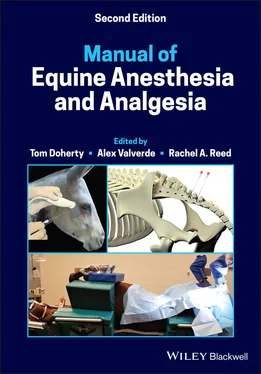This is the site of the majority of K+ and H+ secretion via active transport.
This is the final segment of the nephron, and it has an important role in electrolyte and water absorption.
The collecting duct is under the influence of arginine vasopressin (anti‐diuretic hormone – ADH), which controls the final urine osmolality (concentration).
During states of dehydration, ADH is released from the posterior pituitary, resulting in the insertion of aquaporin channels into the membrane of the cells of the collecting duct.These channels allow the absorption of water, resulting in a concentrated urine.
Equine urine can be very cloudy and foamy, and rather viscous, depending on the horse's diet. (see Figure 5.1)
The cloudiness results from the high concentration of calcium carbonate crystals.Diets high in calcium (e.g. alfalfa) are associated with higher concentrations of calcium carbonate crystals in the urine.Excess dietary calcium is eliminated in the urine and feces.The majority of equine uroliths are composed of calcium carbonate. Figure 5.1 Image of a sample of horse urine. The urine appears cloudy and foamy which is a normal finding.
The foamy and viscous nature of equine urine is due to its high concentration of mucus.Gland‐like structures in the wall of the equine renal pelvis secrete a mucus‐like substance.Mucus has a lubricant function, and helps in preventing the formation of urinary stones from small calcium carbonate crystals.
B Renal blood flow and GFR
Renal blood flow ( RBF )
Is approximately 20% of the cardiac output at rest, and is delivered to the kidneys via the renal arteries.
An uneven distribution exists within the kidney, as the renal cortex receives 90–95% of the blood.
These activities account for about 10% of the body's oxygen utilization.Up to 80% of renal oxygen consumption is used for the process of sodium reabsorption.
This high oxygen demand makes the kidney tubules susceptible to hypoxic damage, such as may occur with a decrease in perfusion during anesthesia.
Renal plasma flow ( RPF )
Is the volume of plasma that flows through the kidney per unit time.
Blood cells and most proteins are too large to be filtered through Bowman's capsule.
The RPF is estimated by multiplying the RBF × (1 − hematocrit [HCT])
Filtration fraction ( FF )
The FF is the fraction of RPF filtered across the glomerulus.Approximately 20% of the RPF enters the capsule.The remaining 80% continues through the renal circulation.
Glomerular filtration rate ( GFR )
The GFR is the volume of filtrate formed by both kidneys per minute.
The GFR is equal to the RPF × FF.
The GFR is determined by:Renal blood flow.Neural and hormonal influences.Intrarenal autoregulation.Plasma oncotic pressure.
This is the intrinsic ability of an organ to maintain normal blood flow despite changes in perfusion pressure.
Autoregulation is intrinsic to the kidneys.Pressures in the range 80–180 mmHg maintain RBF and GFR at steady states.
As pressure increases, flow remains constant if resistance increases proportionately, and vice versa.
Tubuloglomerular feedback ( TGF )
The TGF is a local intrarenal negative feedback mechanism, and is important in regulating the GFR and urine excretion rate.
Within the distal convoluted tubule, specialized cells called the macula densa sense decreased sodium chloride concentrations within the tubular lumen.
This results in a cascade of events resulting in renin release (see Figure 5.2).
The tone of the glomerular arterioles is adjusted to control GFR.
Nitric oxide and adenosine are thought to have an important role in this mechanism.
The formation of urine involves three renal processes:Glomerular filtration.Tubular reabsorption of filtrate.Tubular secretion.
These processes affect the urine volume and its components.
Urine formation is controlled by neurohormonal and physiologic factors regulating sodium and water reabsorption.
These controlling factors include aldosterone, arginine vasopressin, renin, angiotensin II, atrial natriuretic peptide, prostaglandins, catecholamines, arterial blood pressure, and stress.
D Urine volume in the horse
Example : A 450 kg horse (Assume a HCT of 40%)

The GFR greatly exceeds the urine volume, indicating that about 99% of the filtrate is reabsorbed.
Urine production will decrease if there is reduced access to water or food.
III Renin‐Angiotensin‐Aldosterone‐System ( RAAS )(see Figure 5.2)
The role of the RAAS is the long‐term management of blood volume and arteriolar tone.
This is achieved by increasing reabsorption of sodium and water, and increasing vascular tone.
In contrast, the baroreceptor reflex manages smaller and short‐term changes. Figure 5.2 Schematic of the renin angiotensin‐aldosterone‐system (RAAS).
The RAAS has three main components:Renin.Angiotensin II.Aldosterone.
A decrease in renal blood pressure results in these components acting to increase arterial pressure or decrease salt delivery to the distal convoluted tubule.
These mechanisms allow for prolonged increases in systemic blood pressure.
Renin is synthesized by myofibroblast‐like cells located in the renal afferent arterioles.These cells are commonly referred to as juxtaglomerular cells.
The primary physiologic triggers for renin release are:Decreases in extracellular fluid volume.Sodium depletion.Prostaglandins.Hypotension (MAP < 80 mmHg).Increases in sympathetic output.
The factors inhibiting renin release are:Angiotensin II.Atrial natriuretic peptide.Vasopressin.
Renin converts angiotensinogen (a protein synthesized by the liver) to angiotensin I.This is the rate‐limiting step of the RAAS.
Angiotensin I to Angiotensin II
Angiotensin‐converting enzyme (ACE), an enzyme found in vascular endothelium, converts Angiotensin I to Angiotensin II.
Effects of Angiotensin II
It is a potent vasoconstrictor, directly increasing blood pressure by constricting systemic arterioles.
It increases sodium reabsorption, leading to fluid retention and increased extracellular fluid volume.
Catecholamines are released from the adrenal medulla, secondarily affecting systemic blood pressure.
It diminishes the sensitivity of the baroreceptor reflex leading to an increase in blood pressure.
It increases thirst via its effect on the hypothalamus.
It increases the release of ADH. This leads to the insertion of aquaporin channels in the cell membranes of the collecting duct, causing increased water reabsorption.
Angiotensin II has a short half‐life (one to two minutes) in plasma.It is degraded by peptidases into angiotensin III and IV.
Читать дальше













